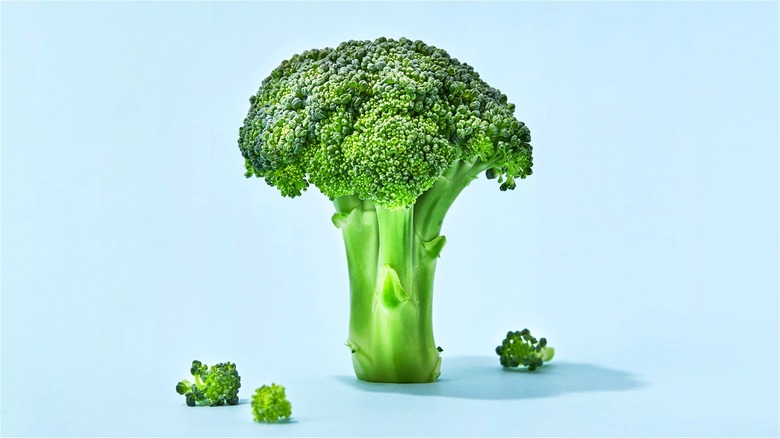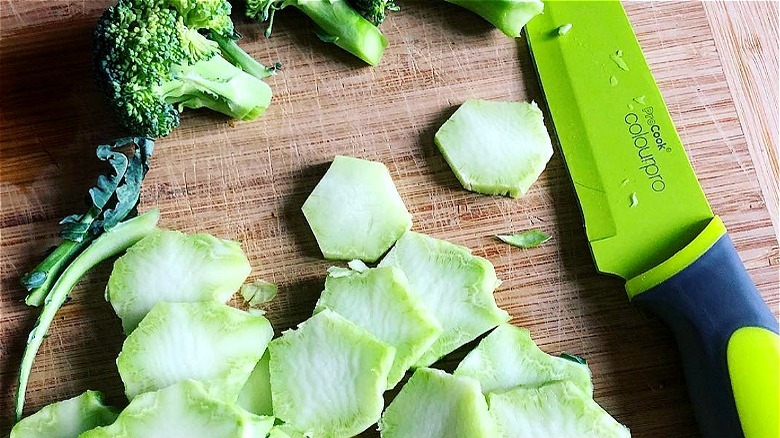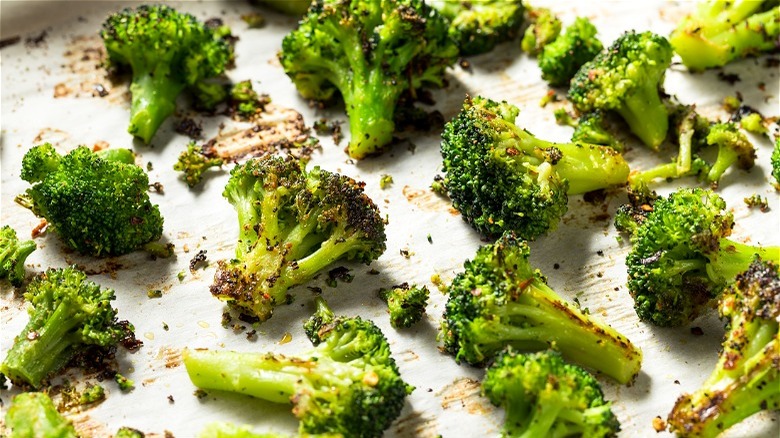Should You Throw Out Broccoli Stalks?
All of us have our own lofty health goals which usually include varying amounts of exercise, adequate sleeping habits, and more nutritious food choices. Yet, the stark reality proves that when it comes to vegetables, we can all try harder. Based on a 2021 survey conducted by OnePoll and Dr. Praeger's, 72% of 2,000 participants wish they ate more vegetables (per SWNS Digital). However, there may be a way to increase your overall consumption if you consider the overlooked parts you're more than likely throwing away amidst the hustle of a busy work week.
You may be unaware that not only are carrot tops edible, but The Guardian claims the greens contain more vitamin C than actual carrots plus a host of other beneficial nutrients. Additionally, the Gardening Channel explains how cauliflower leaves are also a great option when you're trying to save money: You can simply roast the leaves as a simple side dish instead of overbuying expensive greens at the grocery store.
While we should all try to avoid common elements of whole foods that can be toxic like broken cherry pits, how do broccoli stalks measure up? According to a recent 2022 study conducted by Green Giant, out of 5,000 Americans, broccoli reigned as the most popular vegetable in 29 U.S. states so far this year (via The Shelby Report). But are the stalks worth saving?
Broccoli stalks are perfectly safe to eat
In an article titled "Nutritious Foods You Should Stop Throwing Away," in addition to celery leaves and apple peels, The Washington Post claims broccoli stalks are not only perfectly safe to eat, but they're also quite tasty. While the outer exterior may prove to be a tad stringy, all you need is a vegetable peeler. After slicing, chopping, or dicing you're more then free to add the stalks raw or cooked into whatever recipe you choose. FoodPrint. describes the taste of broccoli stems as a palatable blend of broccoli mixed with a mild flavor of water chestnuts.
While you could use these often forgotten broccoli parts to make a lovely vegetable stock with all the leftover peels and trimmings outlined by Blue Apron, you can also transform these food scraps into delicious meals. Food Network lays out the various methods for preparing these mild-flavored parts. Whether you're up for trying Ree Drummond's stir-fried broccoli stems, or Molly Yeh's broccoli slaw, Food Network claims there's no wrong way to use broccoli stalks in your favorite vegetable recipes. Broccoli stalks and florets seem to be used interchangeably but how do they compare on a nutritional level?
What's more nutritious: broccoli florets or broccoli stalks?
Before whipping up a pot of warm broccoli soup with every part of the plant, you may be interested to know which parts of broccoli are the most nutritious. Most people know that generally speaking, broccoli is a highly nutritious vegetable: Healthline claims apart from containing significant levels of manganese, potassium, and vitamin C, broccoli is also a cruciferous vegetable housing special compounds known as isothiocyanates which have been suggested to fight against potential cancers.
According to food expert Tracy Farrell in 2004, the United States Department of Agriculture (USDA) noted exponentially more vitamin A in broccoli florets versus stalks (via The New York Times). Based on one 2018 study of the nutritional components of broccoli by-products, while broccoli florets have higher amino acid content, broccoli leaves prove to be even more nutritious in some elements, containing higher levels of antioxidants and significant amounts of vitamins E and K. While broccoli stalks have a similar nutritional makeup, the florets and leaves tend to be the most nutritious of the three components. So all in all, you're best to hold onto those precious stalks: Not only are they great additions to your favorite broccoli recipes, but they're a healthy option next to America's favorite florets.


